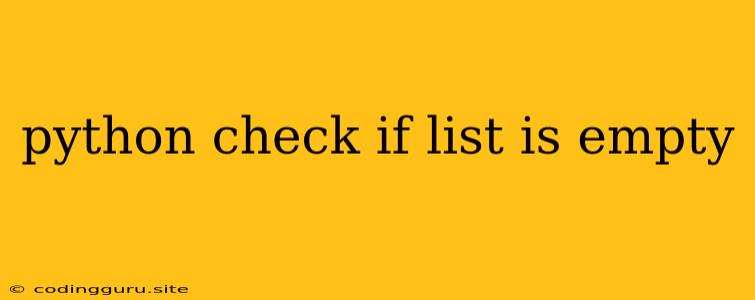How to Check if a List is Empty in Python
In Python, often you need to determine whether a list contains any elements or is completely empty. This is a common task encountered in various programming scenarios. Understanding how to check for an empty list is crucial for effective code execution and error prevention.
Why Checking List Emptiness Matters
Before delving into the methods, let's understand why checking if a list is empty is so important:
- Avoiding Errors: Attempting to access elements in an empty list will result in an
IndexError, causing your program to crash. - Conditional Logic: You might want to execute specific code blocks only if a list has elements, ensuring efficient processing.
- Data Validation: Ensuring that a list contains data before performing operations on it can prevent unexpected behavior.
Methods to Check for an Empty List
Here are the most common ways to check if a list is empty in Python:
1. Using the len() Function
The len() function returns the number of elements in a list. If the list is empty, the length will be 0.
my_list = []
if len(my_list) == 0:
print("The list is empty.")
else:
print("The list is not empty.")
2. Using the not Operator with len()
This method is more concise and readable. The not operator returns True if the length of the list is 0 (empty), otherwise False.
my_list = []
if not len(my_list):
print("The list is empty.")
else:
print("The list is not empty.")
3. Direct Comparison with an Empty List
You can directly compare the list to an empty list using the == operator.
my_list = []
if my_list == []:
print("The list is empty.")
else:
print("The list is not empty.")
4. Using the bool() Function
The bool() function converts an object to a boolean value. An empty list evaluates to False, while a non-empty list evaluates to True.
my_list = []
if not bool(my_list):
print("The list is empty.")
else:
print("The list is not empty.")
Example Scenarios
Let's see how checking for an empty list is used in practical scenarios:
Scenario 1: Reading User Input into a List
numbers = []
while True:
user_input = input("Enter a number (or 'q' to quit): ")
if user_input == 'q':
break
else:
numbers.append(int(user_input))
if numbers: # Check if the list is not empty
print("The numbers you entered:", numbers)
else:
print("You didn't enter any numbers.")
In this example, we collect user input and store it in a list. The if numbers: condition checks if the list is empty before printing the entered numbers.
Scenario 2: Data Processing Based on List Contents
items = ["apple", "banana", "orange"]
if items:
# Process items in the list
for item in items:
print(f"Processing item: {item}")
else:
print("No items to process.")
Here, we have a list of items. The code only executes the processing loop if the list is not empty, ensuring that the program doesn't attempt to process nonexistent items.
Tips for Best Practices
- Choose the method that best suits your code's readability and context.
- Avoid using
if len(my_list) > 0as it is less clear thanif len(my_list). - Using
not my_listmight be confusing since it checks if the list isFalse(empty), which is not the same as comparing it to an empty list.
Conclusion
Checking for an empty list in Python is crucial for writing robust and reliable code. By understanding the various methods and using them appropriately, you can ensure your programs handle list emptiness gracefully and avoid unexpected errors. Remember to choose the method that best fits your coding style and scenario, making your code clear, efficient, and error-free.
